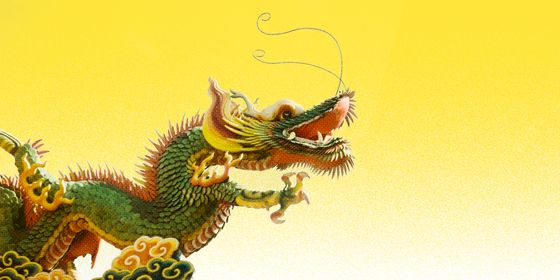Illness is often seen as a disease of disorder in the Chinese language, requiring firm “treatment”
What do disease, a flooding river, and a chaotic state have in common? They all need to be treated, or 治 (zhì). The water radical of the character suggests its root: the original meaning of 治 was to control the flooding river, or 治水 (zhìshuǐ).
To control the Yellow River in particular was a toilsome task. A mixture of early history and myth, the innovative approach to the Yellow River by legendary tribal leader Yu the Great—diverting the water instead of building dams—were seen as a great administrative strategy, making Yu one of the most virtuous leaders in prehistory.
Defending against floods and preventing natural disaster provide political legitimacy, not only for Yu the Great but for emperors in the centuries to come. Therefore, it’s quite understandable that 治 also means “to rule, to govern” as in 治国 (zhìguó, govern a country) and 治军 (zhìjūn, govern the military).
To rule as a king or emperor is 统治 (tǒngzhì). One of the core Confucian beliefs on statecraft is that governing the state starts with oneself, as in the saying from The Great Learning: 修身齐家治国平天下 (xiūshēn qíjiā zhìguó píngtiānxià) or “cultivate oneself, then put the family in order, then govern the state rightly, and bring peace to the world.”
Sounds like too much work? Perhaps you take the more free-spirited Daoist view, which is 无为而治 (wúwéi ér zhì, govern by doing nothing)—rule by non-interference. Unfortunately, only a few rulers in history implemented this idea, and still fewer correctly. Both views assume the governance of state lies on individuals, which is 人治 (rénzhì, govern by people). As to the present day, 依法治国 (tīfǎ zhìguó, govern by law), or 法治 (fǎzhì) for short—seems much more effective and is something China is working toward.
The Chinese equivalent of “politics” is 政治 (zhèngzhì), a term created by the Japanese using Chinese characters during the Meji Restoration in the 1860s. The neologism was quite apt, since both characters have the meaning “to govern state affairs,” and was borrowed back into Chinese.
To govern is to bring order; therefore, 治 also means “stability, order, and peace.”A phrase people often seen on posters and the news in China is 社会治安 (shèhuì zhì’ān), or “public security and order,” which often involves retiree volunteers with red armbands who monitor their neighborhood for suspicious people or activities.
In general, 治理 (zhìlǐ) refers to treatment. It can be used for pollution, corruption, natural disaster, or poverty. In medical contexts, 治病 (zhìbìng, to treat disease), 治疗(zhìliáo, to treat), and 诊治(zhěnzhì, to diagnose and treat) are the words used. For instance, 他的病治好了。 (Tā de bìng zhì hǎo le. He was cured of his sickness.) Modern medicine has successfully cured many diseases, or 治愈 (zhìyù, to cure). But in the unfortunate cases where there is no cure, the disease is called 不治之症 (búzhì zhī zhèng).
Sometimes, this illness can be a figurative one. In the 1942 Yan’an Rectification Movement, Mao Zedong coined the slogan 惩前毖后, 治病救人 (Chéng qián bì hòu, zhìbìng jiùrén). The first part means “to learn from the past mistakes to avoid future ones,” an encouragement of revealing and discussing past mistakes; the latter part literally means “to cure the sickness and save the patient.” The slogan was used to emphasize the importance of ideology and thought reform. Today, the phrase is still often used in state editorials promoting morality among Party members and condemning corruption.
To bring order often involves punishment of wrongdoings, therefore 治 also means “to punish,” as in 惩治 (chéngzhì, to mete out punishment). Another Confucian saying about fair punishment and wise retribution goes: 以其人之道,还治其人之身。(Yǐ qí rén zhī dào, huán zhì qí rén zhī shēn.) It can literally be translated to “take the way the others treat you, and return the treatment to them,” or “an eye for an eye; a tooth for a tooth.”
No matter if it’s disease or a chaotic situation, to merely reduce the symptoms without attacking the cause is called 治标 (zhìbiāo, treat the symptoms). To tackle a problem from the root, one must 治本 (zhìběn, treat the essence).
In some cases, 治 takes on a more general meaning—“to do,” but with a more formal tone. For instance, in 治装 (zhìzhuāng, buy clothes), it means “to purchase”; in 治学 (zhìxué, pursue scholarly work), it means “to pursue.”
From treating rivers and curing disease to governing the state, 治 is a word that embraces peace, health, and order.
On the Character: 治 is a story from our issue, “Vital Signs.” To read the entire issue, become a subscriber and receive the full magazine.













